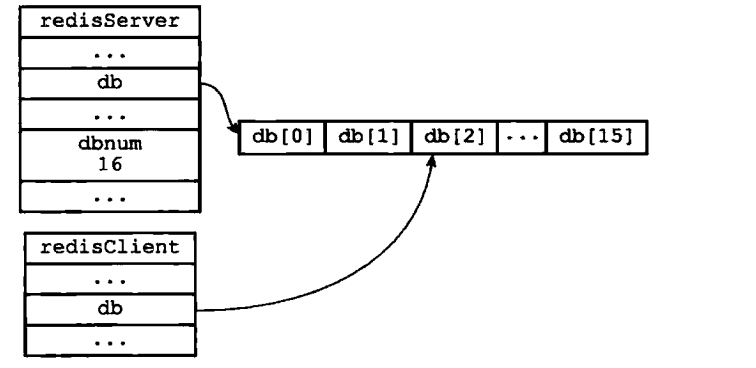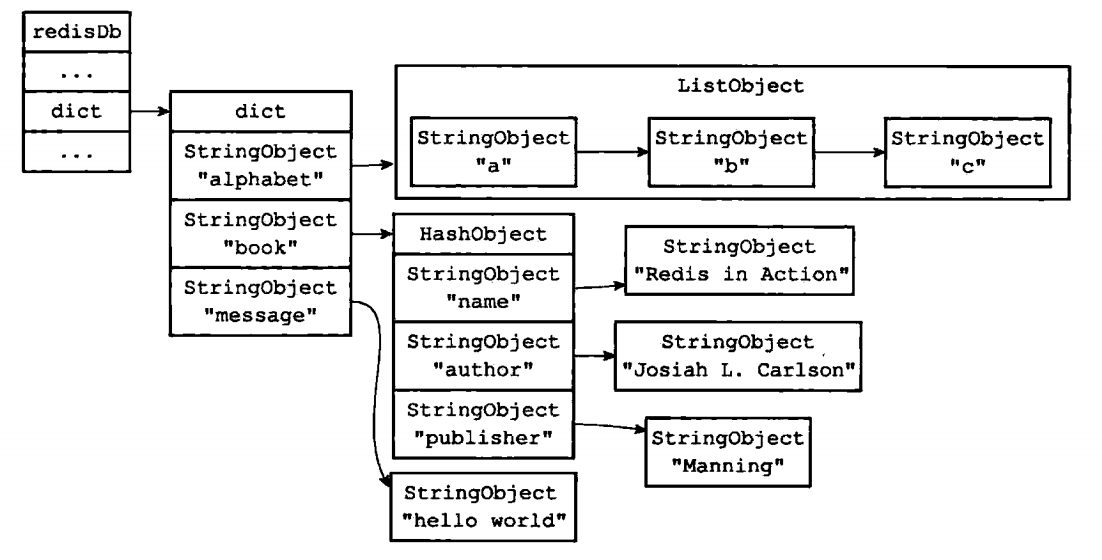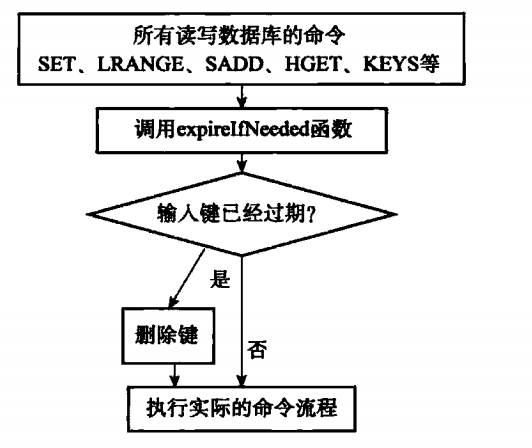概述
1.数据库结构
2.数据库键空间
3.键生存时间
4.持久化对过期键处理
5.数据库通知
1.数据库结构
Redis服务器将所有server状态都保存在数据结构中的db数组,服务器会根据dbnum来决定创建多个个数据库,默认为16个。
struct redisServer { //数据结构里面有很多属性,这里只取了相关的两个来说明 /* General */ redisDb *db; int dbnum; }redisServer;
创建db后,如下所示:

同样的在redisClient的数据结构中,也有一个指向当前db的属性,当在客户端执行select x时,指针就会指向对应的db
typedef struct redisClient { redisDb *db; }redisClient;
如下图所示,客户端选择db 2的时的结构图:

2.数据库键空间
Redis是一个键值对数据库,数据库的所有键值对都保存在字典中,可以看下redisDb的数据结构中,有个dict的属性,称这个字典属性为键空间;
typedef struct redisDb { dict *dict; /* The keyspace for this DB */ dict *expires; /* Timeout of keys with a timeout set */ dict *blocking_keys; /* Keys with clients waiting for data (BLPOP) */ dict *ready_keys; /* Blocked keys that received a PUSH */ dict *watched_keys; /* WATCHED keys for MULTI/EXEC CAS */ struct evictionPoolEntry *eviction_pool; /* Eviction pool of keys */ int id; /* Database ID */ long long avg_ttl; /* Average TTL, just for stats */ } redisDb;
键空间和用户所见的数据库是对应的,比如set msg aaa,对应每个键都是一个字符串对象,每个值可以为字符串对象、列表对象、hash表对象、集合对象等;
比如在客户端命令中,设置几个key对象,一个字符串,一个列表,一个哈希表,如下:
127.0.0.1:6379[12]> set msg 1
OK
127.0.0.1:6379[12]> rpush list "a" "b" "c"
(integer) 3
127.0.0.1:6379[12]> hset book author "Jony"
(integer) 1
127.0.0.1:6379[12]> hset book name "c++"
对应的关系如下:

读写键空间的时候,还有一些其他的维护操作,比如:
1.在读取一个键后(读和写都要读取键空间),服务器会根据键是否存在来更新键空间命中或未命中的次数,可以通过info stats命令查看;
keyspace_hits:12322422
keyspace_misses:1843426
2.在读取一个键后,服务器会更新这个键的LRU(最后一次使用时间),使用object idletime key可以查看这个key的空闲时间,前面章节有讲到过;
3.服务器读取的时候,如果发现key已经过期,则会先删除这个key,再执行余下操作;
4.如果有客户端使用WATCH 命令监视了某个键,服务器会在这个键被修改后,将这个键表尾dirty,从而让事务程序意识到这个键已经被修改了;
5.服务器每次修改一次键,就会将dirty数+1,这个键会触发服务器的持久化及复制操作;
6.如果服务器开启了数据库通知功能,则会在键被修改后,按照配置发送相应的数据库通知。
3.键的生存时间
在Redis中可以通过expire来设置键的过期时间,我们也可以通过ttl key命令来查看键的过期时间。具体是怎样实现的?如果保存的?如何超时的?接下来会分段来讲解。
设置超时
可以通过四种命令来设置key的过期时间:
expire key ttl:设置key的过期时间为ttl秒
pexpire key ttl:设置key的过期时间为ttl毫秒
expireat key timestamp:设置key的过期时间为timestamp所指定的秒数时间戳
pexpireat key timestamp:设置key的过期时间为timestamp所指定的毫秒数时间戳
这个不多说了,四个命令大体类似,最终执行结果和pexpireat一样;
保存过期时间
怎么保存的呢? 看下redisDb的数据结构,有个expires的dict来保存过期的键值对:
typedef struct redisDb { dict *dict; /* The keyspace for this DB */ dict *expires; /* Timeout of keys with a timeout set */ dict *blocking_keys; /* Keys with clients waiting for data (BLPOP) */ dict *ready_keys; /* Blocked keys that received a PUSH */ dict *watched_keys; /* WATCHED keys for MULTI/EXEC CAS */ struct evictionPoolEntry *eviction_pool; /* Eviction pool of keys */ int id; /* Database ID */ long long avg_ttl; /* Average TTL, just for stats */ } redisDb;
dict的键为指向键空间的某个键对象,值为超时时间,比如为某个key通过expire设置了超时时间,那么保存结构如下(键空间的地址其实只有一个),保存的为时间戳:

移除过期时间
通过persist key来移除key的超时时间,即将key对应的键值对从expires字典中移除
返回剩余生存时间
通常通过ttl或者pttl来获取key的剩余生存时间,具体实现为过期时间减去当前时间时间戳
过期键的判断
如果不通过ttl来返回剩余时间,就时间访问expires的dict字典:
1.先检查key是否在expires字典中存在;如果存在则获取时间;
2.获取unix的当前时间戳,如果大于过期时间的话,则过期,否则未过期;
过期键的删除
这个也是面试中比较常问的,给redis键设置超时时间后,到期后怎么就自动删除了?
Redis的删除机制,理论上来将可以有如下考虑:
1.设置定时机制
在给键设置过期时间的时候,同时设置一个定时器,定时器到期后,自动删除;这样做的优点是可以保存过期键能够及时被删除,并释放占用的内存;但是缺点也比较明显,当大量的键存在的时候,对cpu消耗会比较大,这样回导致无法响应正常的请求;
2.惰性删除
key到期后,不去删除它,当需要取key的时候,先获取过期时间,如果超时了,则先删除再进行下一步处理。这样对cpu是最友好的,但是会占用内存,如果过期key比较多,又没有程序使用这些key的话,就会一直占着内存。
3.定期删除
前面两种策略要不就是耗CPU,要不就是耗内存。定期删除每隔一段时间执行过期键的删除操作,并通过限制删除操作执行的时长和频率来减少对cpu的影响。定期删除极大的减少了内存浪费的情况。那定期删除以什么频率和执行时间来操作呢?
redis中过期键的删除策略
redis中采用的删除策略为惰性删除和定期删除两种,配合这两种策略,服务器可以很好的在使用cpu时间和避免内存浪费之间取得平衡。
惰性删除的实现
所有对数据库的读写命令执行之前都会先调用expireIfNeed函数来判断是否超时,具体代码如下:
int expireIfNeeded(redisDb *db, robj *key) { mstime_t when = getExpire(db,key); mstime_t now; if (when < 0) return 0; /* No expire for this key */ /* Don't expire anything while loading. It will be done later. */ if (server.loading) return 0; /* If we are in the context of a Lua script, we claim that time is * blocked to when the Lua script started. This way a key can expire * only the first time it is accessed and not in the middle of the * script execution, making propagation to slaves / AOF consistent. * See issue #1525 on Github for more information. */ now = server.lua_caller ? server.lua_time_start : mstime(); /* If we are running in the context of a slave, return ASAP: * the slave key expiration is controlled by the master that will * send us synthesized DEL operations for expired keys. * * Still we try to return the right information to the caller, * that is, 0 if we think the key should be still valid, 1 if * we think the key is expired at this time. */ if (server.masterhost != NULL) return now > when; /* Return when this key has not expired */ if (now <= when) return 0; /* Delete the key */ server.stat_expiredkeys++; propagateExpire(db,key); notifyKeyspaceEvent(REDIS_NOTIFY_EXPIRED, "expired",key,db->id); return dbDelete(db,key); }
执行流程如下:

定期删除的实现
通过activeExpireCycle函数来实现,该函数会分多次遍历服务器中的各个数据库,从数据库的expires字典中随机取出一部分键的过期时间,并删除其中的过期键;
void activeExpireCycle(int type) { /* This function has some global state in order to continue the work * incrementally across calls. */ static unsigned int current_db = 0; /* Last DB tested. */ static int timelimit_exit = 0; /* Time limit hit in previous call? */ static long long last_fast_cycle = 0; /* When last fast cycle ran. */ int j, iteration = 0; int dbs_per_call = REDIS_DBCRON_DBS_PER_CALL; long long start = ustime(), timelimit; if (type == ACTIVE_EXPIRE_CYCLE_FAST) { /* Don't start a fast cycle if the previous cycle did not exited * for time limt. Also don't repeat a fast cycle for the same period * as the fast cycle total duration itself. */ if (!timelimit_exit) return; if (start < last_fast_cycle + ACTIVE_EXPIRE_CYCLE_FAST_DURATION*2) return; last_fast_cycle = start; } /* We usually should test REDIS_DBCRON_DBS_PER_CALL per iteration, with * two exceptions: * * 1) Don't test more DBs than we have. * 2) If last time we hit the time limit, we want to scan all DBs * in this iteration, as there is work to do in some DB and we don't want * expired keys to use memory for too much time. */ if (dbs_per_call > server.dbnum || timelimit_exit) dbs_per_call = server.dbnum; /* We can use at max ACTIVE_EXPIRE_CYCLE_SLOW_TIME_PERC percentage of CPU time * per iteration. Since this function gets called with a frequency of * server.hz times per second, the following is the max amount of * microseconds we can spend in this function. */ timelimit = 1000000*ACTIVE_EXPIRE_CYCLE_SLOW_TIME_PERC/server.hz/100; //执行时间限制 timelimit_exit = 0; if (timelimit <= 0) timelimit = 1; if (type == ACTIVE_EXPIRE_CYCLE_FAST) timelimit = ACTIVE_EXPIRE_CYCLE_FAST_DURATION; /* in microseconds. */ for (j = 0; j < dbs_per_call; j++) { int expired; redisDb *db = server.db+(current_db % server.dbnum); //从0db开始,依次往上 /* Increment the DB now so we are sure if we run out of time * in the current DB we'll restart from the next. This allows to * distribute the time evenly across DBs. */ current_db++; /* Continue to expire if at the end of the cycle more than 25% * of the keys were expired. */ do { unsigned long num, slots; long long now, ttl_sum; int ttl_samples; /* If there is nothing to expire try next DB ASAP. */ if ((num = dictSize(db->expires)) == 0) { db->avg_ttl = 0; break; } slots = dictSlots(db->expires); now = mstime(); /* When there are less than 1% filled slots getting random * keys is expensive, so stop here waiting for better times... * The dictionary will be resized asap. */ if (num && slots > DICT_HT_INITIAL_SIZE && (num*100/slots < 1)) break; /* The main collection cycle. Sample random keys among keys * with an expire set, checking for expired ones. */ expired = 0; ttl_sum = 0; ttl_samples = 0; if (num > ACTIVE_EXPIRE_CYCLE_LOOKUPS_PER_LOOP) num = ACTIVE_EXPIRE_CYCLE_LOOKUPS_PER_LOOP; while (num--) { dictEntry *de; long long ttl; if ((de = dictGetRandomKey(db->expires)) == NULL) break; ttl = dictGetSignedIntegerVal(de)-now; if (activeExpireCycleTryExpire(db,de,now)) expired++; if (ttl < 0) ttl = 0; ttl_sum += ttl; ttl_samples++; } /* Update the average TTL stats for this database. */ if (ttl_samples) { long long avg_ttl = ttl_sum/ttl_samples; if (db->avg_ttl == 0) db->avg_ttl = avg_ttl; /* Smooth the value averaging with the previous one. */ db->avg_ttl = (db->avg_ttl+avg_ttl)/2; } /* We can't block forever here even if there are many keys to * expire. So after a given amount of milliseconds return to the * caller waiting for the other active expire cycle. */ iteration++; if ((iteration & 0xf) == 0) { /* check once every 16 iterations. */ long long elapsed = ustime()-start; latencyAddSampleIfNeeded("expire-cycle",elapsed/1000); if (elapsed > timelimit) timelimit_exit = 1; } if (timelimit_exit) return; /* We don't repeat the cycle if there are less than 25% of keys * found expired in the current DB. */ } while (expired > ACTIVE_EXPIRE_CYCLE_LOOKUPS_PER_LOOP/4); //循环,如果过期键超过25% } }
该函数怎么调用? 会有个serverCron,默认100ms一次,serverCron会调用databaseCron,databaseCron会调用这个函数进行定期删除key
4.持久化对过期键处理
对于RBD文件,在执行SAVE或BGSAVE命令时,对过期的键不会进行保存到RBD文件中。同理在恢复时,程序会对键的过期时间进行检查,如果过期则不会载入到数据库。
对于AOF文件,如果某个键已经过期,但是还没有到定期删除和惰性删除,对AOF文件没有任何影响。因为当键执行定期删除或惰性删除后,程序会往AOF中追加一个DEL命令。来显示记录该键已经被删除。
在执行AOF重写时,不会将过期的键保存到重写后的AOF文件中。
5.数据库通知
当客户端有订阅某个key时,数据库通知可以在key发生变化时,通知给key的订阅者。